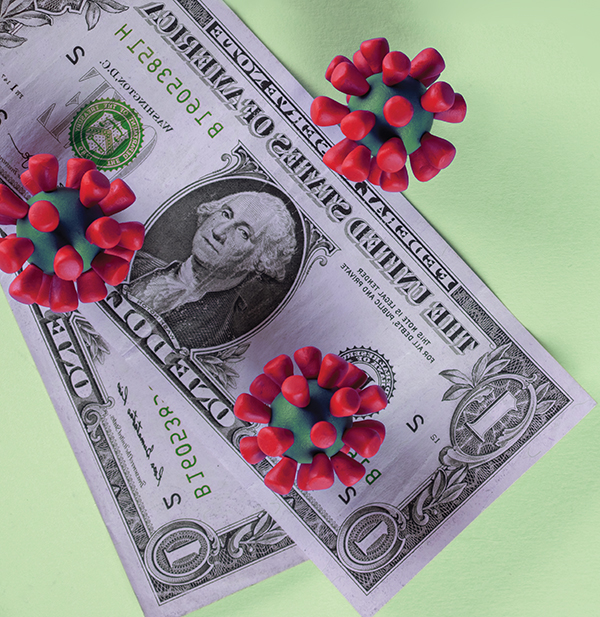 Trying to return to business as usual remains challenging. Just ask Jim Roche, president of the Business and Industry Association (BIA). On Aug. 4, the BIA held its first in-person event since the pandemic hit featuring leading economists as well as Gov. Chris Sununu and former Gov. John H. Sununu sharing “reflections on New Hampshire’s changing economy and culture.”
Trying to return to business as usual remains challenging. Just ask Jim Roche, president of the Business and Industry Association (BIA). On Aug. 4, the BIA held its first in-person event since the pandemic hit featuring leading economists as well as Gov. Chris Sununu and former Gov. John H. Sununu sharing “reflections on New Hampshire’s changing economy and culture.”
While the Manchester Country Club can accommodate up to 300 for an event, the BIA capped it at 115 to allow social distancing and quickly sold out. However, 30 people cancelled in the days before the event, and on the day of, another 50 dropped out. “So we had 35 out of 115 registered people show up,” says Roche. “That told me we are not going to be able to attract people to in-person events going forward. Everything will probably continue to be virtual, including conferences, board meetings and our annual dinner and awards banquet. It’s a crazy new world.”
This “crazy new world” is expected to persist at least until an effective COVID-19 vaccine is developed and in widespread use. Even then, consumer behavior could be changed in ways that create both significant challenges and new opportunities for business.
In a presentation to the BIA, Joe Seydl, senior markets economist with JPMorgan Chase, pointed out that a global recovery is already underway, but some regions are expected to recover faster than others.
China could have GDP back to pre-COVID levels by the end of this year; the U.S. by the end of 2021; and Europe by the third quarter of 2022.
The economy will recover, but will it ever be the same?
“I think there will be some permanent changes,” says Roche, who keeps in regular contact with his 400 business and industry members. “For one thing, there will be less need for office space and more trust in working remotely. Even manufacturers who have to have people on the production floor won’t have as many people in the office. COVID-19 has proven businesses can be just as productive with people at home as in the office.”
Economist Russ Thibeault, president of Applied Economic Research in Laconia, agrees, saying, “Will we get back to exactly the way things were? Probably not. I’ve talked to a lot of people who are actually very comfortable working at home and prefer it, find it more productive. A lot of businesses that have closed aren’t coming back. People who might not have retired, decided to retire earlier than expected.”
The Bifurcated Economy
Just as the effects of the COVID-19 slowdown vary widely from one sector to another, so will the rebound. “That’s part of the structural change this economy has brought about,” says Thibeault. “Some sectors and activities will return to what we thought was normal; others won’t.”
Not surprising, since the slowdown has been uneven, it is challenging to providing a peek into the future.
Early signs point to a decline in commercial real estate, at least in the short-term. “I’ve got a friend with a lot of commercial property,” says Roche, “and he’s seeing retailers struggling substantially and not renewing leases. Even office tenants are not renewing or seeking reduced rates.”
Thibeault describes the current state of affairs as a “bifurcated economy,” in which a significant portion of the population has prospered during the COVID slowdown. “White-collar workers who can work at home are doing pretty well,” he says. “The housing market is very strong. Housing prices are going up in double digits.” But other businesses, particularly those that rely on providing services in person, are hurting. “The restaurant sector, mom and pop retailing, hospitality in general is just doing terrible, even when we had the stimulus,” Thibeault says.
From July 2019 to July 2020, spending on air travel declined 75%, recreation spending declined 45% and spending on food services declined 25%. In the same period, spending on automobiles and furniture rose 5%, while spending on recreation vehicles increased 30%, according to the U.S. Bureau of Economic Statistics. Those hardest hit by the downturn will likely have the most difficult time in recovery, and that applies to workers as well as businesses.
“The bifurcated economy has an age dimension to it as well,” says Thibeault. “Economically, this has been much harder on young people than on the middle-aged and elderly. If you’re on a fixed income, that’s fortuitous. But a lot of young people who work in restaurants, retailing, entry-level jobs, they are really hurting. It’s really had a more pronounced impact on the lifestyles and economic performance of young people.”
An Unequal Recovery
Seydl, at the BIA conference, suggested that while the economy is recovering, “it has been an unequal recovery so far” when it comes to goods versus services. Americans were spending roughly the same amount on goods and services in January 2020, but by April, spending on services had dropped to 80% of pre-COVID levels, while spending on goods had declined by much less, to around 87% of pre-COVID levels, according to the U.S. Bureau of Economic Statistics.
The difference in the bounce-back has been even more dramatic. By the end of July, spending on goods actually exceeded pre-COVID levels by about 5%, but spending on services was still more than 10% below pre-COVID levels, according to the U.S. Bureau of Economic Statistics.
The good news, according to the economists, is that the slowdown has been driven by lack of supply, not demand, and as Seydl notes, “Recoveries from supply recessions historically have been much faster [to recover] than those of demand recessions.”
Demand has been propped up by an unprecedented infusion of federal funds into consumer and business bank accounts through grants, loans and supplemental unemployment insurance. In the first half of the year, GDP declined nearly 10%, while personal income rose 10%, an unprecedented divergence. How long that lasts remains to be seen and will depend largely on the nature and size of any future stimulus.
Adapt or Perish
Incremental changes to last year’s business plan won’t be sufficient in most cases to ensure a business will survive the COVID economy, Thibeault says.
“I think it’s important to have your break-even revenue volume at a level that can support your business,” he says. “Small businesses have to be able to survive with lower revenues than they were accustomed to, and that may mean don’t add a lot of debt; be careful and try to keep your break-even point as low as is practical. Be cautious about taking on new costs; try to be flexible; and adapt to this if you can adapt. You have to have a strategy to outlast the downturn.”
Another example of that adaptation is in health care, where telemedicine is taking off. “Health care organizations have been adapting in a fairly significant way over the past five to 10 years, but it’s going to be on hyper speed for the next couple of years,” says Kevin O’Leary, CFO at Exeter Hospital.
One example is the rapid adaptation of telehealth technologies that enable remote monitoring of vital signs, EKG or blood pressure and remote consultations.
Exeter Hospital CEO Kevin Callahan points to steps the organization has taken that are consistent with the advice from Thibeault and others. “We have had to curtail expenses as best as we can, and constrain our benefit and compensation costs because we don’t want to furlough or layoff staff,” he says.
Callahan is convinced that business as usual won’t cut it in the post-COVID era. “If you’re not evolving and adapting, you’re going bankrupt,” he says.
How One of NH’s Top Developers is Surviving the COVID Economy Developer Dick Anagnost (pictured), president of Anagnost Investments, is known for commercial, residential and medical projects in NH and beyond. Given his company’s diverse portfolio, he’s seen the effect of COVID-19 on the economy from a variety of perspectives.
Developer Dick Anagnost (pictured), president of Anagnost Investments, is known for commercial, residential and medical projects in NH and beyond. Given his company’s diverse portfolio, he’s seen the effect of COVID-19 on the economy from a variety of perspectives.
Anagnost’s holdings also include Dunkin’ franchises, a hair-care products company, a company that distributes components for high-tech manufacturing, five charitable gaming operations in NH and a bowling alley in Dover.
Before COVID-19, he had about 3,600 employees across all companies nationally and now is down to just below 3,000 with around 500 to 600 in NH. “We’ve hired back about 80% but are still 20% below where we were,” Anagnost says. “The rest aren’t back for a number of reasons. One is that business hasn’t returned to the way it was.”
Anagnost says his businesses are building back up, but slowly, and on average are about 50% below pre-COVID revenue levels, with restaurants hurting the most. He believes businesses hard hit by COVID-19 can survive and emerge even stronger if they can keep expenses, especially payroll, reasonably close to revenues and get creative with the business model.
“Control costs, work hard and save as much as you can because cash is going to be king moving forward,” he says. “You have to be innovative. When my hair care products shut down because there was no demand, we converted our lines and made hand sanitizers and disinfectants. We started creating products we would not normally sell. Be creative and be flexible.”
Evolution will be key to survival, Anagnost says. “As you evolve, you reconfigure and change the business model to meet the new normal. Those are the people who are going to survive and become successful,” he says.

 Current Issue - April 2024
Current Issue - April 2024